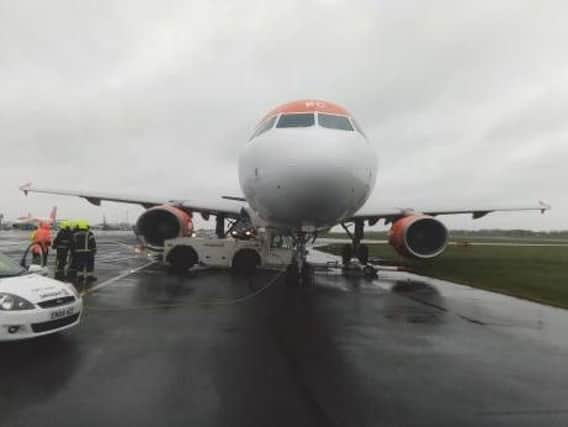Passenger jet crashed into tow truck before Belfast to Malaga flight


The pilot, the AAIB reported on Thursday, radioed 'STOP, STOP, STOP' to ground crew while being pushed away from a gate at Belfast International Airport because he was concerned the plane was moving towards the grass immediately before the collision on April 3.
The incident occurred during rainy conditions, said the AAIB.
Advertisement
Hide AdAdvertisement
Hide AdDamage was caused to the leading edge of the plane's No 2 engine nacelle, the underside of its fuselage, the leading edge of it right wing, its nose landing gear, and its tyre. There were no injuries when the tug - a small motor vehicle that pulls planes across the apron - and aeroplane collided.
A spokesperson for Easyjet told this paper that the safety of its passengers was its utmost priority.
“We assisted with the AAIB’s investigation and we welcome the safety actions taken by our ground handling partners at Belfast. The safety of those onboard was not compromised at any time. The safety and wellbeing of our passengers and crew is the airline’s highest priority,” the spokesperson said.
A spokesperson for the handling agent Swissport said: “We can confirm that an aircraft at Belfast International Airport was damaged on 3 April 2019 as it was made ready for its journey from the parked position. An immediate investigation took place and learnings have been implemented.
“We apologise for any inconvenience caused to passengers.”
Advertisement
Hide AdAdvertisement
Hide AdDetails of the incident were outlined by the AAIB in its November bulletin.
"While being pushed back from Stand 18 at Belfast International Airport, the aircraft was stopped with the tug and tow bar positioned at a significant angle to the aircraft’s nose. The tow bar disconnected from the nose landing gear, and the aircraft rolled forward and struck the tug.
"The handling agent carried out an internal investigation and initiated Safety Action," the AAIB said.
According to the AAIB's investigation the pilot became concerned at the direction of travel of the plane while it was being pushed out for take-off.
Advertisement
Hide AdAdvertisement
Hide Ad"Both engines were started during the pushback, which appeared normal to the flight crew until, part of the way around the 90° turn to face west, the commander became aware that the aircraft was close to the edge of the apron.
"He questioned the situation with the member of the groundcrew on the headset and was told the situation was 'OK'. The aircraft stopped at an angle to the taxiway centreline with the nose pointing towards the grass area beyond the edge of the apron.
"It then started to move forward which the commander thought was to align it with the taxiway centreline, but he quickly became concerned about the direction of travel, which was towards the grass, and called the groundcrew to 'STOP, STOP, STOP'," the AAIB reported.
At this point, the AAIB investigation found, there was no reply, and the pilot did not apply his brakes because he thought he was still being towed.
Advertisement
Hide AdAdvertisement
Hide Ad"There was no reply to his instruction, but he did not apply the aircraft’s wheel brakes because the operator’s SOPs prevented him from doing so while under tow (to prevent damage to the nose landing gear by the tug pushing or pulling against the aircraft brakes).
"Shortly afterwards the aircraft stopped, accompanied by an unfamiliar noise which was the underside of the aircraft contacting the roof of the tug cab," said the AAIB.
After the engines were shut down the airport Rescue and Fire Fighting Service (RFFS) inspected the damage and the fire crew informed the pilot that "the number two engine was damaged but there was no fuel leak and no need for an evacuation".
According to a report from the ground handling agent the rainy conditions had a role to play in the incident.
Advertisement
Hide AdAdvertisement
Hide Ad"The tug driver had difficulty seeing the taxi line due to the wet reflective surface of the apron and the tug was struggling to move the aircraft due to a high gear having been selected. The turn to L3 was made late and the aircraft’s position was closer to the edge of the apron than normal," it found.
The AAIB concluded: "During the pushback, the left turn was made beyond the correct turning point because the tug driver had difficulty seeing the taxi line in the wet reflective surface of the apron.
"The aircraft was stopped with the tug and tow bar positioned at a significant angle to the right of the aircraft’s nose and, at some point, the tow bar disconnected from the nose landing gear.
"The aircraft rolled forward slowly, and the flight crew believed it was still under tow and they could not apply aircraft brakes. The aircraft was brought to a halt when it struck the tug."